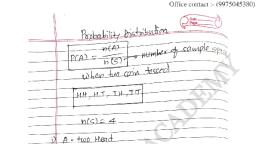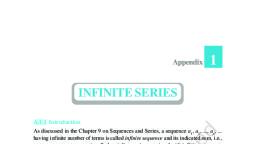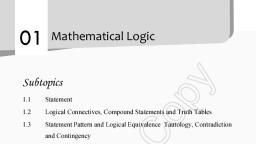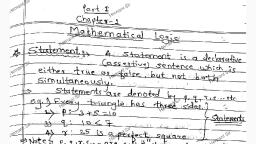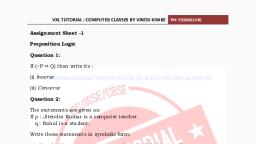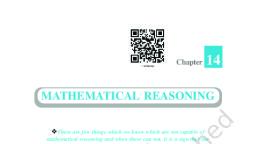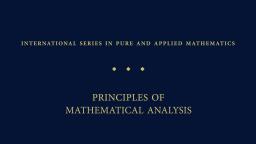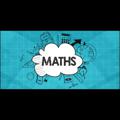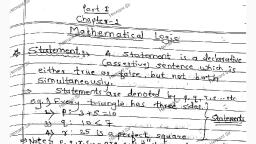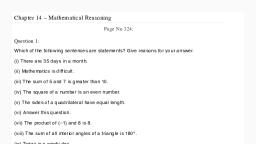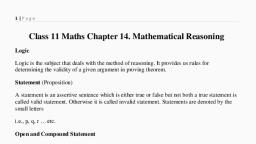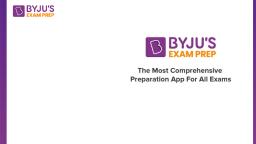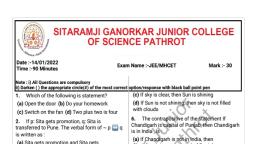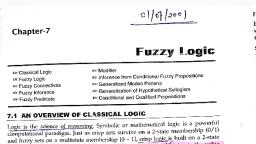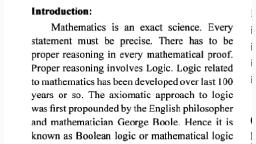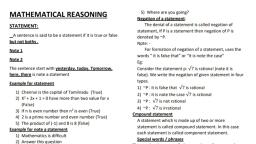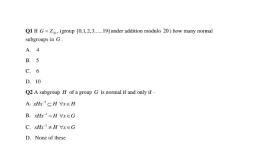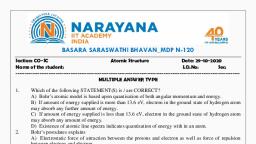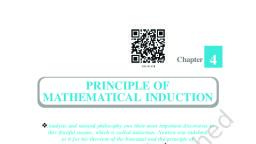Page 1 :
Mathematical Logic, Textbook, Chapter No., 01, Subtopics, Aristotle (384 - 322 B.C.), Statement,, Logical Connectives, Compound, 1.1, Aristotle, the, philasopher and thinker, luid the foundetions of, great, Statements and Truth Table, Statement Pattern, Logical Equivalence, and, Algebra of Statements, Tautology, Contradiction, Contingency, 1.2, study, of, logic, systematic form. The, study of logic helps in, increasing one's ability, of systematic and logical, reasoning and develops, in, 1.3, Quantifiers and Quantified Statements, Duality, 1.4, Negation of compound statements, Switching cireuit, 1.5, the, 1.6, tunderstanding, Chapter at a glance, thent, 1., Statement, A statement is declarative sentence which is either true or false, but not both simultaneously., Statements are denoted by lower case letters p, q, r, ctc., The truth value of a statement is denoted by '1' or 'T' for True and '0' or 'F' for False., Open sentences, imperative sentences, exclamatory sentences and interrogative sentences are not, considered as Statements in Logic., 2., Logical connectives, Type of compound statement, Conjuction, Disjunction, Negation, Connective, Symbol, Example, p and q: pAq, p or q: pvq, negation p: -p, not p:p, If p, then q: p, p iffq : p <>q, and, or, V, not, Conditional or Implication, Biconditional or Double implication, if....then, » or >, if and only if i.e. iff, > or, When two or more simple statements are combined using logical connectives, then the statement so, formed is called Compound Statement., ii., i., Sub-statements are those simple statements which are used in a compound statement., i11., In the conditional statement p q, p is called the antecedent or hypothesis, while q is called the, consequent or conclusion., 3., Truth Tables for compound statements:, i., ii., Negation:, Conjuction, Disjunction, Conditional and Biconditional:, -p, T., T., T, T, F, F, F, T, F, T., F, T, F, F, F, F, T, 16
Page 2 :
4., Relation between compound statements and sets in set theory:, i., Negation corresponds to 'complement of a set'., Disjunction is related to the concept of 'union of two sets',, ii., Conjunction corresponds to 'intersection of two sets'., iii., iv., Conditional implies 'subset of a set'., Biconditional corresponds to 'equality of two sets'., v., Statement Pattern:, 5., When two or more simple statements p, q, r... are combined using connectives A, v,, statement formed is called a statement pattern., e.g.: - paq, pa (pA q), (q → p) vr, + the new, Converse, Inverse, Contrapositive of a Statement:, If p q is a conditional statement, then its, 6., i., Converse:, ii., Inverse: -p-, Contrapositive: -p, 7., Logical equivalence:, If two statement patterns have the same truth values in their respective columns of their joint truth table, then these two statement patterns are logically equivalent., Consider the truth table:, -p, T, T, F, F, T, F, F, F, T, T., T, F, F, T, From the given truth table, we can summarize the following:, The given statement and its contrapositive are logically equivalent., i.e. p→q = ~q-p, i., ii., The converse and inverse of the given statement are logically equivalent., i.e. q → p=-p→~ q, 8., Algebra of statements:, i., pvq =qvp, Commutative property, paq=qAp, (p v q) vr =p v (q v r) = p vq vr, (p^ q) Ar=pA (q a r) = pnqar, ii., Associative property, }, }, pv (q a r) = (p v q) a (p v r), pa (q v r) = (p A q) v (p a r), Distribùtive, property, - (p v q) = -p ^~q, - (pn q) =-pv~9, iv., De Morgan's laws, V., p→ q =-p vq, p+q = (p > q) a (→ p), = (- pv q) ^ (- q v p), pv (pa q) = p, p^ (p v q) = p, Conditional laws, vi., } Absorption law
Page 3 :
ILT denotes the tautology and F denotes the contradiction, then for, vii., any statement 'p':, pvT= T; p v F= p, } Identity law, a., b., p^T = p; pA F=F, viii. a., pv-p=T, } Complement law, b., pA-p= F, -(-p) = p, ix., a., T F, Involution laws, b., - F='T, C., pvp=p, } Idempotent law, х., pap=p, Types of Statements:, If a statement is always true, then the statement is called a "tautology"., If a statement is always false, then the statement is called a "contradiction" or a "fallacy"., 9., i., ii., iii., If a statement is neither a tautology nor a contradiction, then it is called "contingency"., 10. Quantifiers and Quantified Statements:, i., The symbol 'stands for "all values of " or "for every" and is known as universal quantifier., ii., The symbol 3' stands for "there exists atleast one" and is known as existential quantifier., iii., When a quantifier is used in an open sentence, it becomes a statement and is called a quantified statement., 11. Principles of Duality:, Two compound statements are said to be dual of each other, if one can be obtained from the other by, replacing "A" by "v" and vice versa. The connectives "A" and "v" are duals of each other. If 't' is tautology, and 'c' is contradiction, then the special statements 't' & 'c' are duals of each other., 12. Negation of a Statement:, - (p v q) =-pA~, - (p→ q) = pA- q, - (- p) = p, - ( for all / every x) = for some / there exists x, ii., - (p a q) =- pv~q, iii., iv., - (p + q) = (p A~ q) v (q ^ ~ p), V., vi., XE = (xA)~=, - (for some / there exist x) = for all / every x, vii., >- (3 x) = Vx, viii. - (x< y) = x2y, - (x> y) =x<y, . Application of Logic to Switching Circuits:, i., AND : JA] (Switches in series), Let p : S, switch is ON, S2, q: S2 switch is ON, For the lamp L to be 'ON' both S, and S2 must be ON, Using theory of logic, the adjacent circuit can be expressed as, p A q.
Page 4 :
(A) Ram is not lazy and he fails in the, (C) Ram is lazy or he does not fail in the, (B) Ram is not lazy or he does not fail in the, (D) Ram is not lazy and he does not fail in, 11. If p: Ram is lazy, q: Ram fails in the, iii. If two or more switches open or close simultancously then the switches are denoted by the same, OR : Iv] (Switches in parallel), Let p: S, switch is ON, q : Sz switch is ON, For lamp L to be put ON either one of the two, ii., switches S, and S2 must be ON., Using theory of logic, the adjacent circuit can be expressed as p v q., letter., If p: switch S is closed., -p: switch S is open., If S, and S2 are two switches such that if S, is open S2 is closed and vice ver, then S =- S2, or, S2 = - S, Classical Thinking, has set, q: The moon has risen, then symbolically the statement 'The sun has, not set or the moon has not risen' is written as, 7., 1.1, Statement,, Logical, Compound Statements and Truth Table, Connectives,, (B) qvp, (D) -pv-q, 1., Which of the following is a statement in logic?, (A) What a wonderful day!, (B) Shut up!, (C) What are you doing?, AÐ) Bombay is the capital of India., Which of the following is a statement?, (A) Open the door., (B) Do your homework., (C) Switch on the fan., (D) Two plus two is four., If p: Rohit is tall, q: Rohit is handsome, the, the statement 'Rohit is tall or he is short and, handsome' can be written symbolically as, (A) pv (-pA q), (В) рл(-руq), (C) pv (p A -q), (D) -pA (-p ^-q), 2., 9., S Marheatics, Assuming the first part of the statement as p., second as q and the third as r, the statement, "Candidates are present, and voters are ready to, vote but no ballot papers' in symbolic form is, (A) (p v, (C) (-p ^ q) A ~r, Which of the following is a statement in logic?, (A) Go away, Je) x> 5, 3., (B) How beautiful!, (D) 2= 3, v q) ^ -r, (B) (p^ -q) Ar, (D) (p a q) A -r, 4., The, connective, in, the, statement, Write verbally -p v q where, p: She is beautiful; q: She is clever, (A) She is beautiful but not clever, (B) She is not beautiful or she is clever, (C) She is not beautiful or she is not clever, (D) She is beautiful and clever., 10., "Earth revolves around the Sun and Moon is a, satellite of earth", is, (A) or, (C) Sun, (B) Earth, (Đ) and, p: Sunday is a holiday, q: Ram does not study, on holiday., The symbolic form of the statement, "Sunday is a holiday and Ram studies on, holiday' is, (A) p^-q, (C) -p^~q, 5., examination, then the verbal form of -p v -4, (B) рла, (D) ру-9, examination., examination., 6., p: There are clouds in the sky and q : it is not, raining. The symbolic form is, (А) р >9, (C) p^-4, examination., (B) p-q, (D) pAq, the examination.
Page 5 :
aical Logic, If m: Rimi likes calculus., n: Rimi opts for engineering branch., Then the verbal form of m->n is, (A) If Rimi opts for engineering branch then, 20., (A) p is false., (B) q is false,, (C) both p and q are false., (D) depends on p, 12, she likes calculus., (B) If Rimi likes calculus then she does not, opt for engineering branch., (C) If Rimi likes calculus then she opts for, engineering branch, (D) If Rimi likes engineering branch then, and, q., 13., when, (А) рis true., (B) q is true., i) both p and q are true., of p and q is true., she, opts, for calculus., (D) none, 21. The inverse of logical statement p q is, . For the statements p and q 'p q' is read as, ifp then q'. Here, the statement q is called, (A) antecedent., (B) consequent., (C) logical connective., (D) prime component., (A) -p →-q, (В) ред, (C) 9→P, (D) q> p, 22. Contrapositive of p→ q is, 15. Ifp: Prakash passes the exam,, q: Papa will give him a bicycle., Then the statement 'Prakash passing the exam,, implies that his papa will give him a bicycle', can be symbolically written as, (A) p→9, (С) рла, (B) -9→p, (D) q--p, The statement "If x is not even then x is not, even", is the converse of the statement, (A) Ifx is odd, then x is even, (B) Ifx is not even, then x is not even, (C) Ifx is even, then x is even, (D) Ifx is odd, then x is even, 23., (B) p+q, (D) pуя, 16. If d: driver is drunk, a: driver meets with an, accident, translate the statement 'If the Driver, is not drunk, then he cannot meet with an, accident' into symbols, 24., The converse of 'If x is zero then we cannot, divide by x' is, (A) If we cannot divide by x then x is zero., (B) If we divide by x then x is non-zero., (C) Ifx is non-zero then we can divide by x., (D) If we cannot divide by x then x is, (A) -a →-d, (C) -da a, (B) -d -a, (D) ал-d, 17. If a: Vijay becomes a doctor,, b: Ajay is an engineer., Then the statement 'Vijay becomes a doctor if, and only if Ajay is an engineer' can be written, in symbolic form as, (A) b+-a, (C) a → b, non-zero., The converse of the statement "If x > y, then, x+a>y+a", is, (A) Ifx <y, then x + a<y+ a, (B) Ifx + a >y +a, then x>y, (C) Ifx<y, then x + a >y+a, (D) Ifx>y, then x + a<y+ a, 25., YB) a +b, (D) b→a, * A compound statement p→q is false only when, (A) p is true and q is false., (B) p is false but q is true., (C) atleast one of p or q is false., (D) both p and q are false., 19., The inverse of the statement "If you access the, internet, then you have to pay the charges", is, (A) If you do not access the internet, then, you do not have to pay the charges., (B) If you pay the charges, then you, accessed the internet., 26., Assuming the first part of each statement as p,, second as q and the third as r, the statement If, A, B, C are three distinct points, then either, they are collinear or they form a triangle' in, symbolic form is, (C) If you do not pay the charges, then you, do not access the internet., (A) p+ (q vr), (C) p (qvr)/, (D) You have to pay the charges if and only, If you access the internet., (В), (pA q) →r, (D) p (qar), 171
